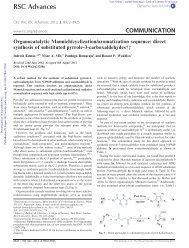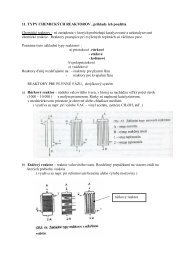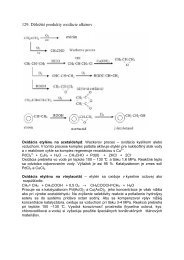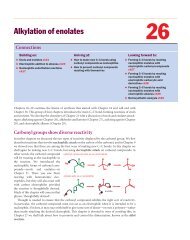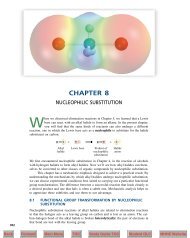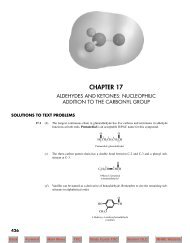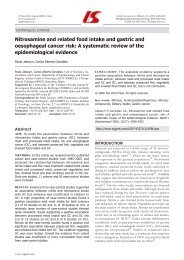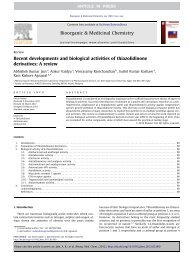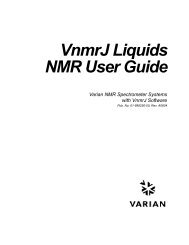Create successful ePaper yourself
Turn your PDF publications into a flip-book with our unique Google optimized e-Paper software.
with CH 2Cl 2 afforded a crystalline crude product that was recrystallized (CCl 4); yield:<br />
1.15 g (72%); mp 1228C.<br />
<strong>13</strong>.<strong>13</strong>.1.1.3 By Formation of Two N-C Bonds<br />
<strong>13</strong>.<strong>13</strong>.1.1.3.1 Fragments N-N-N and C-C<br />
The most important and general approach to the synthesis of the 1,2,3-triazole ring system<br />
involves azides. A wide variety of azides (organic or inorganic) can be used: alkyl,<br />
aryl, hetaryl, acyl, alkoxycarbonyl and sulfonyl azides, azidotrimethylsilane, hydrazoic<br />
acid, sodium azide, etc. All are suitable reagents for triazole synthesis.<br />
Azides react with various types of compounds to yield 1,2,3-triazoles or their immediate<br />
precursors. The most used are: (i) compounds with C”C bonds (here referred to as<br />
alkynes, irrespectively of other functional groups), (ii) compounds with C=C bonds (here<br />
referred to as alkenes, and including allenes, enamines, enol ethers, etc.), and (iii) activated<br />
methylene compounds.<br />
In spite of the great usefulness of the azides in the triazole synthesis, if the reaction<br />
conditions (especially the temperature) are not well controlled, the products obtained<br />
may be not the expected triazoles. This is because of the thermal instability of the azides<br />
and of some of the intermediates (dihydrotriazoles) formed during the triazole synthesis.<br />
[75] It is very important to always consider that most organic azides undergo thermal<br />
or photochemical decomposition to nitrenes. The decomposition temperature is dependent<br />
on the azide type (Table 2) and some azides, especially cyanogen azide and the lower<br />
alkyl azides, are unpredictably explosive. When the decomposition is carried out in the<br />
presence of an alkene the corresponding aziridine is usually obtained. [75]<br />
Table 2 Decomposition Temperature of Azides [76]<br />
Azide Type Decomposition Temp (8C) Ref<br />
alkyl azides 180–200 [76]<br />
aryl azides 140–170 [76]<br />
sulfonyl azides 120–150 [76]<br />
alkoxycarbonyl azides 100–<strong>13</strong>0<br />
[76]<br />
acyl azides 25–80 [76]<br />
<strong>13</strong>.<strong>13</strong>.1.1.3.1.1 Addition of Azides to Alkynes<br />
FOR PERSONAL USE ONLY<br />
438 Science of Synthesis <strong>13</strong>.<strong>13</strong> 1,2,3-<strong>Triazoles</strong><br />
The thermal 1,3-dipolar cycloaddition of azides to alkynes is often the method of choice<br />
for the synthesis of 1,2,3-triazoles since it gives directly the desired product. However,<br />
when unsymmetrical alkynes are used, mixtures of the two possible regioisomers are<br />
usually obtained. In general, addition to unsymmetrical alkynes tends to give mainly the<br />
isomers with the electron-withdrawing groups at the 4-position and the electron-releasing<br />
groups at 5-position. [3] The low regioselectivity of these reactions is the major disadvantage<br />
of this method as a preparative procedure. The accepted mechanism for these reactions<br />
is a concerted 1,3-dipolar cycloaddition. Kinetic data and the regio- and stereoselectivity<br />
of these reactions strongly support this mechanism. However, the reactions involving<br />
ionic azides (e.g., sodium azide) follow a nonconcerted ionic mechanism. These<br />
mechanisms have been discussed and documented in reviews. [76,77]<br />
N-Unsubstituted 1,2,3-triazoles are prepared by the direct addition of hydrazoic acid<br />
or an azide ion to alkynes but it is often more convenient to obtain these compounds by<br />
removal of a N-substituent from a 1H- or2H-triazole.<br />
A. C. TomØ, Section <strong>13</strong>.<strong>13</strong>, Science of Synthesis, 2004 Georg Thieme Verlag KG




